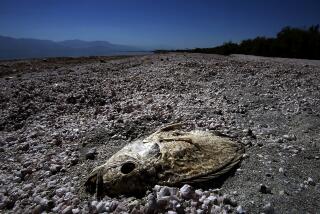Pollution Blamed : Marine Life Dying in North and Baltic Seas
- Share via
COPENHAGEN — Pollution is killing off marine life in the Baltic Sea and North Sea.
In the Baltic, biologists have found seals starving to death because their mouths and fins are so badly deformed that they can’t catch enough fish to eat.
Danish fishermen have seen tens of thousands of fish floating belly-up in some of their best North Sea fishing grounds. The Swedes have seen the same thing.
Lobsters Turn Black
Choice red Norwegian lobsters caught off northern Denmark have turned black.
For a decade, marine experts have been warning of a creeping “sea death” as a result of steadily growing nitrogen and phosphorus emissions from public sewage plants, industry and farms.
But no notice was taken until last fall, when the environmental emergency in southern Scandinavian waters became obvious to government officials.
Studies revealed that big patches of the sea bottom are lifeless because of a lack of oxygen in the water.
Algae Steal Oxygen
Nitrogen and phosphorus, especially from agricultural fertilizers, combine to stimulate an explosive growth of algae, which rot and then rob the sea of oxygen vital to marine life on the bottom.
Atmospheric fallout of such heavy metals as cadmium, chromium, nickel, lead and zinc is also poisoning the seas.
“I don’t want to be a doomsday prophet,” said David Rehling, director of the Danish Society for Conservation of Nature, “but we had a catastrophe in 1986 when all marine life in an area totaling 100 square kilometers (40 square miles) was wiped out.”
“The scientists tell us--and they may be right or wrong--that the North Sea in the next 15 years will suffer loss of life in vast areas.”
Rehling said that, given current agricultural practices, he foresees a time when many farmers will go out of business due to soil exhaustion.
‘Bluff and Bully’
“We wish the farmers had a bit more foresight, . . . but the agricultural organizations still think they can bluff and bully their way through this problem.”
Since 1981, the “sea death” syndrome has been registered with rising frequency in ever-widening areas.
“The amount of nitrogen and phosphorus that has been let out has increased steadily, and we know now that agricultural soil is so full of these chemicals that ever greater amounts will seep out,” Rehling said.
Fishermen report that a 2,000-square-mile area of the Kattegat Strait between Denmark and Norway is so badly polluted that formerly bountiful stocks of plaice, cod and dab fish have disappeared. They blame the farmers.
Arne Nielsen, director of the Danish Environment Ministry’s Ocean Research Institute, said the pollution is so heavy that it will take years for the pool of “nitrogen-heavy” water to disappear.
Seas Not ‘Self-Rinsing’
Recent research has disproved the hypothesis that the seas are efficiently “self-rinsing.”
It takes about 30 years for a total rinsing of the 164,000-square-mile Baltic, the world’s largest body of brackish water. Not even the 200,000-square-mile North Sea, which draws upon the Atlantic Ocean, is able to flush itself adequately.
Nielsen said most scientists are convinced that the deterioration of the seas is due to various chemical pollutants, but they can’t prove it.
“It takes a lot of time, a lot of study,” he said. “We don’t have the figures. When we go to the farmers, they say: ‘Can you prove it?’ ”
Rehling’s 400,000-member organization drafted a six-point “Save the Seas Around Denmark” program that the government adopted after wrangling with the powerful farm lobby.
A key point calls for a 50% cut in all agricultural emissions of nitrogen and phosphorus within two years.
Opposed by Farmers
The measure was strongly opposed by Danish farmers whose highly profitable, intensive agricultural techniques are made possible by dumping about 400,000 tons of nitrogenous fertilizers into the soil each year. Of this amount, about 260,000 tons seep into Danish waters.
“If we can reduce nitrogen in the next five years, we may see some positive results at the turn of the century,” said Nielsen.
Farmers are not the only ones singled out as polluters.
Industry and public sewage plants in Sweden, Finland, the Soviet Union, Poland and East Germany pour 50,000 to 100,000 tons of phosphorous, 500,000 to 1 million tons of nitrogen and enormous amounts of lead, zinc cadmium and insecticides into the Baltic every year.
More to Read
Sign up for Essential California
The most important California stories and recommendations in your inbox every morning.
You may occasionally receive promotional content from the Los Angeles Times.










